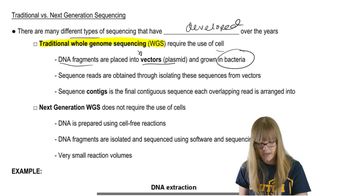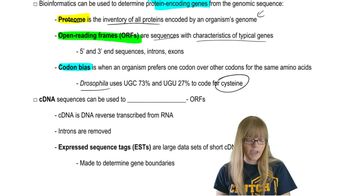Table of contents
- 1. Introduction to Genetics51m
- 2. Mendel's Laws of Inheritance3h 37m
- 3. Extensions to Mendelian Inheritance2h 41m
- 4. Genetic Mapping and Linkage2h 28m
- 5. Genetics of Bacteria and Viruses1h 21m
- 6. Chromosomal Variation1h 48m
- 7. DNA and Chromosome Structure56m
- 8. DNA Replication1h 10m
- 9. Mitosis and Meiosis1h 34m
- 10. Transcription1h 0m
- 11. Translation58m
- 12. Gene Regulation in Prokaryotes1h 19m
- 13. Gene Regulation in Eukaryotes44m
- 14. Genetic Control of Development44m
- 15. Genomes and Genomics1h 50m
- 16. Transposable Elements47m
- 17. Mutation, Repair, and Recombination1h 6m
- 18. Molecular Genetic Tools19m
- 19. Cancer Genetics29m
- 20. Quantitative Genetics1h 26m
- 21. Population Genetics50m
- 22. Evolutionary Genetics29m
15. Genomes and Genomics
Sequencing the Genome
Problem 1d
Textbook Question
In this chapter, we focused on the analysis of genomes, transcriptomes, and proteomes and considered important applications and findings from these endeavors. At the same time, we found many opportunities to consider the methods and reasoning by which much of this information was acquired. From the explanations given in the chapter, what answers would you propose to the following fundamental questions?
How do we know which contigs are part of the same chromosome?
 Verified step by step guidance
Verified step by step guidance1
<span>Step 1: Understand the concept of contigs. Contigs are contiguous sequences of DNA that are assembled from overlapping shorter sequences obtained from sequencing projects.</span>
<span>Step 2: Consider the use of genetic markers. Genetic markers, such as known genes or sequences, can be used to map contigs to specific locations on a chromosome.</span>
<span>Step 3: Explore the use of paired-end reads. Paired-end reads provide information about the distance between two sequences, helping to link contigs that are physically close on the same chromosome.</span>
<span>Step 4: Examine the use of optical mapping. Optical mapping provides a high-resolution map of a chromosome, which can be used to align contigs to their correct positions.</span>
<span>Step 5: Investigate the use of synteny with related species. Comparing the order of genes in related species can help infer the arrangement of contigs on a chromosome.</span>
Recommended similar problem, with video answer:
 Verified Solution
Verified SolutionThis video solution was recommended by our tutors as helpful for the problem above
Video duration:
1mPlay a video:
Was this helpful?
Key Concepts
Here are the essential concepts you must grasp in order to answer the question correctly.
Contigs
Contigs are contiguous sequences of DNA that are assembled from overlapping fragments during genome sequencing. They represent a portion of a chromosome and are crucial for reconstructing the complete genomic structure. Understanding how contigs are formed and aligned helps in identifying their relationships and determining which contigs belong to the same chromosome.
Recommended video:
Guided course

Traditional vs. Next-Gen
Chromosome Mapping
Chromosome mapping involves determining the relative positions of genes or contigs on a chromosome. Techniques such as genetic mapping and physical mapping are used to establish these relationships. By analyzing the order and distance between contigs, researchers can infer which contigs are part of the same chromosome based on their proximity and linkage.
Recommended video:
Guided course

Mapping with Markers
Bioinformatics Tools
Bioinformatics tools are software applications and algorithms used to analyze biological data, including genomic sequences. These tools facilitate the comparison of contigs, alignment of sequences, and identification of shared markers or features. Utilizing bioinformatics is essential for accurately determining the relationships between contigs and confirming their association with specific chromosomes.
Recommended video:
Guided course

Bioinformatics

 8:55m
8:55mWatch next
Master Sequencing Overview with a bite sized video explanation from Kylia Goodner
Start learning



